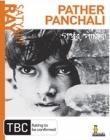Pather Panchali (1955) |
|
Pather Panchali (1955) |
|


|
| BUY IT |
| General | Extras | ||
| Category | Drama | Biographies-Crew-Director Satyajit Ray (2.10) | |
| Rating |

|
||
| Year Of Production | 1955 | ||
| Running Time | 120:00 | ||
| RSDL / Flipper | No/No | Cast & Crew | |
| Start Up | Menu | ||
| Region Coding | 1,2,3,4,5,6 | Directed By | Satyajit Ray |
|
Studio
Distributor |
 Umbrella Entertainment |
Starring |
Kanu Bannerjee Karuna Bannerjee Subir Bannerjee Uma Das Gupta Chunibala Devi Runki Banerjee Reba Devi Aparna Devi |
| Case | Amaray-Transparent | ||
| RPI | ? | Music | Ravi Shankar |
| Video | Audio | ||
| Pan & Scan/Full Frame | None | Dolby Digital 2.0 (192Kb/s) | |
| Widescreen Aspect Ratio | None | ||
| 16x9 Enhancement | No | ||
| Video Format | 576i (PAL) | ||
| Original Aspect Ratio | 1.33:1 | Miscellaneous | |
| Jacket Pictures | No | ||
| Subtitles | English | Smoking | No |
| Annoying Product Placement | No | ||
| Action In or After Credits | No | ||
Pather Panchali (1955) was the first film in Indian director Satyajiy Ray's Apu Trilogy. In fact it stands as a cornerstone of modern Indian cinema.
For those who see Indian cinema as confined to Bollywood spectacle Pather Panchali is a superb eye-opener : a neo-realist film about life in provincial Bengal. It tells the story of the trials and tribulations of a young boy, Apu (pronounced oo poo) living with his mother, father, sister and elderly aunt.In the subsequent films Apu would grow up and experience first hand the struggle of adulthood.
The making of Pather Panchali is as much a story as the film itself. Ray came from a family of artistic achievers. He completed an Economics degree then went into fine arts. His interst in film led him to found the Calcutta Film Society. Through this he met French master Jean Renoir and during a visit to London in 1950 he allegedly saw 95 films in 5 months. The film that impressed him the most was The Bicyle Thief and he took neo-realist principles to heart. Determined to make a film on his return to India he chose as his vehicle the novel Pather Panchali by Bibhutibhushan Banerji. The making of the film took four years. He struggled to get any funding selling everything in the process. He had never directed before and his cinematographer Subrata Mitra had never used a film camera. There was little in the way of a script. Ray had illustrated a script and he and the actors (three of the leads, though not related, had the surname Banerjee!) devised the dialogue for the scenes.
He used theatre actors for the adult leads. He even coaxed aged actress Chunibala Devi out of retirement from the brothel in which she was living to appear as the auntie. She died before the premiere of the film.
The result is a film that is so true to life that it stands as both a theatrical document and a study of rural Indian life. Apu is born into a Bengali family,the son of a priest who is at heart a frustrated writer. Whilst supportive of his ambitions his long suffering wife is worn out from constantly trying to make ends meet. Their daughter Durga is resentful of the wealthier neighbours and is often accused, quite rightly, of stealing fruit from the orchard of the neighbours. The fruit isn't for her - she gives it to the aged Auntie who lives with them in their tiny dwellings. Mother and Auntie don't get on - mother is very resentful of Auntie imposing on them when they have so little. Apu is but a wide eyed observer of the moving tapestry of life's rich pageant.
The film is observational. Many find it slow as Ray is content to train his camera on the family and watch them work through their problems. There is no plot as such rather a succession of life incidents. In one of the best known scenes Apu and Durga race to watch a steam train pass by, having heard but never seen the mighty engine before.
There is death and drama as well as love and happiness but the film never seems to be a melodrama. It is really a documentary-like gaze into how the other half lives.
Pather Panchali won the Grand Prix at the Cannes Film Festival in 1956. It is a moving film and one that should be seen by any student of cinema.
Pather Panchali is presented on DVD in it's original 1.33:1 cinematic aspect ratio.It is not a full frame transfer.
Legend has it that the original negative for this film was destroyed in a fire. On the evidence of this transfer the fire must have spread into the DVD factory. It is a shocker with every artefact known to film on display. There are scratches, blotches, dirty bits and faded sections. The film jumps about at times but I don't blame the telecine - it was doing its best to keep up!
The print is faded in parts and there are a few missing frames. Grain is constant although varying in intensity. Suprisingly I didn't notice compression issues despite the fact that there is 4 hours of film on this dual layer DVD.
I don't begrudge a film of this history and age looking this bad but it would have been nice if some effort could have been made to restore it.
There are English subtitles which for the most part convey the on-screen dialogue although there are a couple of points where, for example in the travelling players section, the translation is partial only.
| Sharpness | |
| Shadow Detail | |
| Colour | |
| Grain/Pixelization | |
| Film-To-Video Artefacts | |
| Film Artefacts | |
| Overall |
The sound for Pather Panchali is Bengali Dolby Digital running at 192 Kb/s.
The quality of the sound is on par with the visuals. There is a constant hiss and numerous pops and crackles. Dialogue is clear enough and looks to be in proper audio sync. The music is by Ravi Shankar, before he became an inspiration to The Beatles and fathered Norah Jones, and consists of a few sitar ragas and some flute music. Apparently Shankar wasn't able to see much more than excerpts from the film and composed and played the music for the soundtrack in one night.
| Dialogue | |
| Audio Sync | |
| Clicks/Pops/Dropouts | |
| Surround Channel Use | |
| Subwoofer | |
| Overall |
There is only one extra on the DVD but it is a doozy. It is a two hour documentary on the craft of Ray by filmmaker Shyam Benegal. The film starts with an extended view of Ray on the set of his film The Home and the World. Without subtitles and seeming direction this segment is a concern until the film proper kicks in with lengthy excerpts from Rays films and even lengthier interview segments. Ray is an excellent speaker and he sets out his life and the process behind his art. Anyone remotely interested in Ray must watch this documentary despite the fact that it is technically poor being an unrestored film from the 80's.
NOTE: To view non-R4 releases, your equipment needs to be multi-zone compatible and usually also NTSC compatible.
Pather Panchali has been released on DVD in Region 1 and 2. The Region 2 contains an excerpt from a Ray interview and some of the storyboards (in reality the real script) of the film. The Region 1 edition apparently contains no extras. All editions are of poor picture quality.
Pather Panchali is indispensible viewing for anyone remotely interested in non-Bollywood Indian cinema.
The experience does require quite a bit of patience as the sound and vision are poor.
The extra, though also old and tired, is a great feature on this important director.
| Video | |
| Audio | |
| Extras | |
| Plot | |
| Overall |
| Review Equipment | |
| DVD | Pioneer BDP-LX70A Blu-ray Player, using HDMI output |
| Display | Pioneer PDP-5000EX. This display device has not been calibrated. This display device is 16x9 capable. This display device has a maximum native resolution of 1080p. |
| Audio Decoder | Built in to amplifier/receiver. Calibrated with Ultimate DVD Platinum. |
| Amplification | Onkyo TX-SR605 |
| Speakers | JBL 5.1 Surround and Subwoofer |